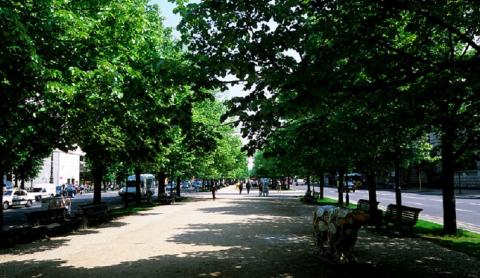
When thinking of tree conservation, sprawling forests generally come to mind. But cities, although covering only 2% of land globally, could harbour a sixth of the world’s tree diversity, according to Australian researchers.
And among the more than 4,700 tree species they counted, one in 10 faces conservation risk in the wild. Six are even thought to be extinct.
“Urban areas represent an overlooked opportunity for plant conservation globally,” says lead author Alessandro Ossola from Macquarie University.
“Our study suggests that meaningful biological conservation of plant diversity can be done on our very doorsteps – in our suburbs and home gardens. We can transform our entire cities into rich botanic gardens where everyone can help by saving plant species from the global extinction crisis that biodiversity is facing.”
After settling towns and cities, our ancestors imported and bred new cultivars and varieties of trees for both aesthetic and practical purposes, and these remain with us today. But they have been overlooked, according to Ossola.
“Despite this rich history, we know surprisingly little about ‘tree life’ in the city and how [urban] trees cope with climate change,” he says.
To understand which trees are planted in cities around the world, and the climates and natural habitats they face, his team conducted an ambitious inventory as part of their Which Plant Where project. They discovered a wealth of data on trees in cities and towns, systematically mining nearly 13 million tree planting records from 2010.
Read more…
When thinking of tree conservation, sprawling forests generally come to mind. But cities, although covering only 2% of land globally, could harbour a sixth of the world’s tree diversity, according to Australian researchers.
And among the more than 4,700 tree species they counted, one in 10 faces conservation risk in the wild. Six are even thought to be extinct.
“Urban areas represent an overlooked opportunity for plant conservation globally,” says lead author Alessandro Ossola from Macquarie University.
“Our study suggests that meaningful biological conservation of plant diversity can be done on our very doorsteps – in our suburbs and home gardens. We can transform our entire cities into rich botanic gardens where everyone can help by saving plant species from the global extinction crisis that biodiversity is facing.”
After settling towns and cities, our ancestors imported and bred new cultivars and varieties of trees for both aesthetic and practical purposes, and these remain with us today. But they have been overlooked, according to Ossola.
“Despite this rich history, we know surprisingly little about ‘tree life’ in the city and how [urban] trees cope with climate change,” he says.
To understand which trees are planted in cities around the world, and the climates and natural habitats they face, his team conducted an ambitious inventory as part of their Which Plant Where project. They discovered a wealth of data on trees in cities and towns, systematically mining nearly 13 million tree planting records from 2010.

